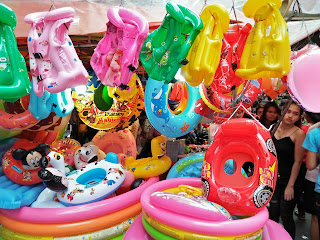EcoWaste Coalition Reminds Parents to Choose Safe Swimming Toys for Kids
The EcoWaste Coalition reminded parents to go for kid-safe
swimming toys as many families head to beaches and pools to seek a breather
from the scorching summer heat.
The anti-toxics watch group revealed that some beach and pool balls, floats and rings being sold in the market may contain undisclosed chemicals of concern such as phthalates that are not permitted in children’s toys.
“We advise parents to only buy safe swimming toys that will not pose chemical risk or cause accidental drowning or injuries to young children,” said Thony Dizon, Chemical Safety Campaigner, EcoWaste Coalition.
“Get your children out of harm’s way, please make them play with phthalate-free swimming toys that are compliant with the government’s regulation,” he said.
Dizon explained that inflatable aquatic toys made
of polyvinyl chloride (PVC) plastic may contain phthalate additives that are
known to interfere with hormonal functions and causing developmental,
reproductive and other health problems, especially among children.
“As a precaution, the Department of Health (DOH) in 2011 banned certain phthalates in children’s toys. As early as 1999, the Bureau of Food and Drugs (now known as the Food and Drug Administration or FDA) warned ‘phthalates in children’s toys particularly those made of soft plastic materials or PVC have been found to leach out from the toys when they are sucked or chewed as commonly practiced by children… (and) may cause adverse health effects such as liver and kidney wounds, reproductive abnormalities and immune system defects’,” he pointed out.
As per DOH Administrative Order 2009-0005-A as amended in December 2011, the manufacture, importation, distribution and sale of children’s toys containing more than 0.1 percent of di-(2-ethylhexyl) phthalate (DEHP), dibutyl phthalate (DBP) or benzyl butyl phthalate (BBP) is prohibited.
“As a precaution, the Department of Health (DOH) in 2011 banned certain phthalates in children’s toys. As early as 1999, the Bureau of Food and Drugs (now known as the Food and Drug Administration or FDA) warned ‘phthalates in children’s toys particularly those made of soft plastic materials or PVC have been found to leach out from the toys when they are sucked or chewed as commonly practiced by children… (and) may cause adverse health effects such as liver and kidney wounds, reproductive abnormalities and immune system defects’,” he pointed out.
As per DOH Administrative Order 2009-0005-A as amended in December 2011, the manufacture, importation, distribution and sale of children’s toys containing more than 0.1 percent of di-(2-ethylhexyl) phthalate (DEHP), dibutyl phthalate (DBP) or benzyl butyl phthalate (BBP) is prohibited.
This A.O. further bans diisononyl phthalate (DINP), diisodecyl phthalate (DIDP), or di-n-octyl phthalate (DnOP) in children’s toys that can be placed in a child’s mouth in concentrations above 0.1 percent by weight.
Dizon recalled that in 2015, three of the four swimming toys sent by the EcoWaste Coalition to a private laboratory for phthalate analysis were found to contain high concentrations of DEHP up to 19.6 percnet and DINP up to 1.29 percent in blatant breach of the government’s regulation.
The fourth sample marked “phthalate-free” on the label passed the test – a good indicator that swimming toys can be manufactured without phthalate additives.
For children’s safety, the EcoWaste Coalition further enjoined the public to heed the pointers from FDA on the proper selection of aquatic toys, including checking the label for the age suitability, item/model/stock keeping unit (SKU) number, warning statements, name and address of manufacturer and license to operate number (LTO No.) of the local company responsible for placing the product in the market.
-end-
Reference:







Comments